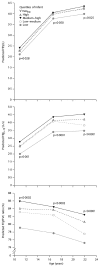Impact of environmental chemicals on lung development
- PMID: 20444669
- PMCID: PMC2920089
- DOI: 10.1289/ehp.0901856
Impact of environmental chemicals on lung development
Abstract
Background: Disruption of fundamental biologic processes and associated signaling events may result in clinically significant alterations in lung development.
Objectives: We reviewed evidence on the impact of environmental chemicals on lung development and key signaling events in lung morphogenesis, and the relevance of potential outcomes to public health and regulatory science .
Data sources: We evaluated the peer-reviewed literature on developmental lung biology and toxicology, mechanistic studies, and supporting epidemiology.
Data synthesis: Lung function in infancy predicts pulmonary function throughout life. In utero and early postnatal exposures influence both childhood and adult lung structure and function and may predispose individuals to chronic obstructive lung disease and other disorders. The nutritional and endogenous chemical environment affects development of the lung and can result in altered function in the adult. Studies now suggest that similar adverse impacts may occur in animals and humans after exposure to environmentally relevant doses of certain xenobiotics during critical windows in early life. Potential mechanisms include interference with highly conserved factors in developmental processes such as gene regulation, molecular signaling, and growth factors involved in branching morphogenesis and alveolarization.
Conclusions: Assessment of environmental chemical impacts on the lung requires studies that evaluate specific alterations in structure or function-end points not regularly assessed in standard toxicity tests. Identifying effects on important signaling events may inform protocols of developmental toxicology studies. Such knowledge may enable policies promoting true primary prevention of lung diseases. Evidence of relevant signaling disruption in the absence of adequate developmental toxicology data should influence the size of the uncertainty factors used in risk assessments.
Figures



References
-
- Andersen DH. Incidence of congenital diaphragmatic hernia in the young of rats bred on a diet deficient in vitamin A. Am J Dis Child. 1941;62:888–889.
-
- Babiuk RP, Thebaud B, Greer JJ. Reductions in the incidence of nitrofen-induced diaphragmatic hernia by vitamin A and retinoic acid. Am J Physiol Lung Cell Mol Physiol. 2004;286(5):L970–L973. - PubMed
-
- Barker DJP. The origins of the developmental origins theory. J Intern Med. 2007;261:412–417. - PubMed
-
- Barker DJP, Osmond C. Infant mortality, childhood nutrition and ischaemic heart disease in England and Wales. Lancet. 1986;1:1077–1081. - PubMed
Publication types
MeSH terms
Substances
LinkOut - more resources
Full Text Sources
Medical

